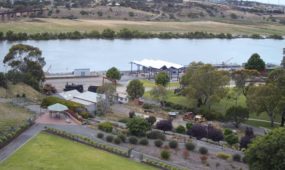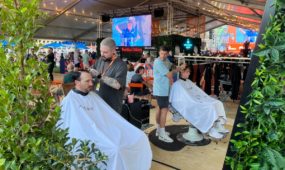Redeveloped stadium becomes tourism drawcard
Tourism
TAKING a traditional sporting ground and turning it into a major tourism drawcard has been a five-year journey at one of the world’s most iconic venues.

Sign up to receive notifications about new stories in this category.
Thank you for subscribing to story notifications.
Two years on from the completion of a $535 million redevelopment at Adelaide Oval, the South Australian icon is being hailed as the driving force behind the state capital’s revitalization.
Last weekend the four-millionth visitor strolled through the gates since the revamp was completed in 2014. But the oval’s pull on non-event days through guided tours and museum visits has also boosted its appeal to tourists.
In April it will launch its first adventure tourism experience – a roof climb allowing harnessed participants to venture along a walkway atop the western and southern grandstands to take in aerial views of the ground and the Greater Adelaide area.
Of the four million visitors since March 2014, slightly more than half were for Australian Rules Football matches while about 1.1 million came to watch cricket – the World Cup match between India and Pakistan in February 2015 was among the most watched matches ever, with a global television audience of more than a billion people.
The rest were made up of people attending soccer matches, concerts and other events.
Stadium Management Authority Chief Executive Andrew Daniels said visitors were not limited to people attending sporting events.
Daniels said the number of people paying to go on volunteer-led tours of the ground had increased more than ten-fold from 3000 a year to 34,000 since the redevelopment.
He said people on the tours were not necessarily visitors who had come to South Australia to attend an Adelaide Oval event.
“We know there can be three or four thousand people from interstate attending a football match. For the Rolling Stones concert we sold over 10,000 tickets interstate,” Daniels said.
“It’s actually for the broader range of tourists too … it’s really getting on the general tourism agenda as well.
“The tours take people right around the stadium and through the changing rooms, the media area and the old scoreboard is always a favourite.
“It’s quite an amazing tourism experience. We’ve been working very closely with the SA Tourism Commission on adding this as one of the must dos when people come and visit South Australia.”
Daniels said the roof climb, which begins on April 6, was the first of several new offerings to be rolled out at the oval in the next four or five years.
He said participants on the climb could sit on a viewing deck jutting out from the southern stand roof and look down over the oval from directly above the football goal square.
“We’re the only stadium in the world to have seats on its roof and it’s going to be an amazing addition – it’s what makes the Adelaide Oval special and different from other stadia around the world,” Daniels said.
The oval was established by the South Australian Cricket Association (SACA) in 1871 and over the next 140 years became world famous for its magnificent playing surface, historic scoreboard and picturesque location just north of the city in parklands between the River Torrens and St Peter’s Cathedral.
As pressure mounted to bring Australian Rules Football matches into the city from their home of almost 40 years at a suburban stadium at West Lakes, SACA members voted in 2011 to accept $535 million in government funding and push ahead with the proposed upgrade. However, a condition of the redevelopment was to maintain the oval’s traditional scoreboard, northern grassed mound, Moreton Bay fig trees and view of the cathedral.
Since 2014, the oval has been the home ground to AFL clubs Port Adelaide Power and Adelaide Crows in the winter months. In the summer, it continues to be South Australia’s major cricket venue and has hosted World Cup matches, the Big Bash League and the first ever day/night Test match in 2015.
The stadium upgrade and the footbridge over the River Torrens linking it directly to the city were among the first projects completed in the Adelaide Riverbank Precinct project. The Riverbank revamp includes upgrades and extensions to the Adelaide Festival Centre, Convention Centre, Adelaide Casino and the establishment of Adelaide BioMed City, a world-class health precinct.
South Australian Premier Jay Weatherill said more than seven per cent of the four million visitors to the revamped oval had come from interstate or overseas.
“The redeveloped Adelaide Oval has become the centrepiece of the revitalisation of our city,” Weatherill said.
“What’s more, that economic activity is conservatively estimated to have created the equivalent of about 700 jobs in the city, generating wages and business incomes of $158 million.”
Jump to next article



